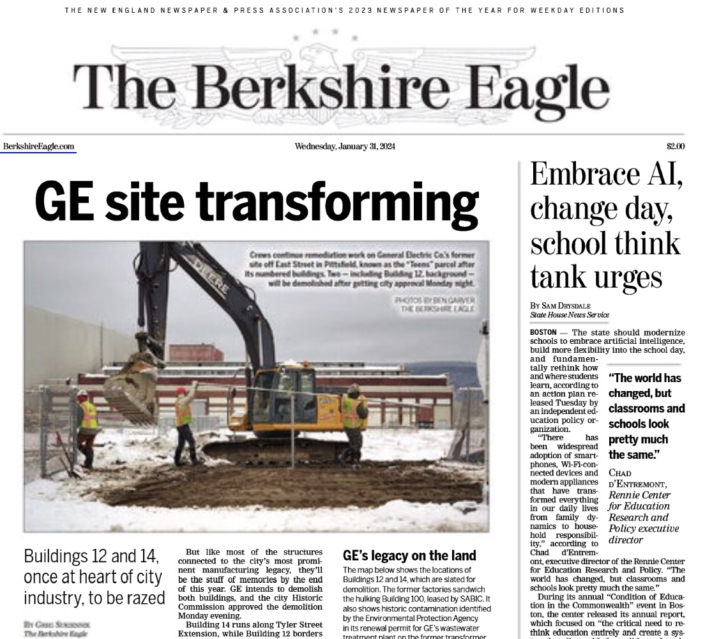GE’s Building 12 and Building 14 in Pittsfield will be gone by the end of this year.
READ THE ARTICLE AT THE BERKSHIRE EAGLE
By Greg Sukiennik
Berkshire Eagle
(c) 2024 The Berkshire Eagle
PITTSFIELD — When General Electric’s Power Transformer division was at its peak of employment and production, Building 12 and Building 14 were among the busiest locations on the company’s massive manufacturing campus.
But like most of the structures connected to the city’s most prominent manufacturing legacy, they’ll be the stuff of memories by the end of this year. GE intends to demolish both buildings, and the city Historic Commission approved the demolition Monday evening.
Building 14 runs along Tyler Street Extension, while Building 12 borders the CSX rail right of way. They stand on opposite sides of Building 100, a massive structure that runs from Merrill Road west toward what was the heart of the Power Transformer plant.
Building 12, listed by the Historic Commission as built in 1914, was a manufacturing and testing space, adjacent to train tracks that carried Pittsfield- built transformers to power installations around the world. Building 14, which was built in 1931 according to the Historic Commission, was home to the Tank Shop, where metal tanks used as transformer cooling systems were fabricated. Both buildings sprouted multiple additions as GE grew.

This drawing from a Citizens Coordinating Council meeting last year shows the location of the Building 12 and Building 14 complexes, which are slated to be demolished this year. At left (labeled PEDA) is Site 9 of the William Stanley Business Park.

Members noted that although GE submitted lists of the buildings’ functions rather than a detailed history, a great deal of written and photo history of the Transformer site, written by Thomas Blalock, already exists.
Glenn Milarczyk, representing GE contractor Brandenburg Industrial Service Company of Bethlehem, Penn., briefly outlined how the buildings would be taken down. “We do take great pride in making sure we have a safe proper job site,” he said.
“The history of [the buildings] is pretty cool,” Milarczyk said. “But they’re ugly, to be simple about it … I think it’s time for those buildings to go away.”
The matter now reverts back to the city to issue a permit.
The two buildings form a sandwich around Building 100, a massive rectangle of structural steel which was completed in 1968. Following the closure of Power Trans-former, it was used by GE Plastics, and leased in part by Husky Injection Molding. It’s presently being leased by SABIC’s polymer processing development center.
According to a Citizens Coordinating Council presentation from May 24 of last year, the U.S. Environmental Protection Agency signed off GE’s demolition work plan effective Jan. 1, 2023. According to EPA, the demolition is subject to local and state law, while disposal is under EPA jurisdiction.
According to EPA, demolition debris from the two buildings will be consolidated, buried and sealed in an existing sub-surface vault within Building 12. Asbestos, liquids, hazardous materials and other materials that do not fit in the vault will be sent to a licensed off-site disposal facility. “EPA considers this a positive development as it is part of the overall improvement of this portion of the city from the eyesore and safety hazard that it currently is,” agency spokesperson Jo Anne Kittrell said Tuesday.
Air quality monitoring will be required, as well as post-construction groundwater monitoring wells. A cap will then be installed atop the site, with a low-permeability liner and either asphalt, concrete, or vegetated topsoil.
According to a map included in the EPA’s draft permit for renewal of GE’s wastewater treatment operations, Building 12 sits on the perimeter of non-aqueous phase liquid pollution (NAPL) contamination— hydrocarbons that don’t dissolve in water.
That map shows both light and heavy concentrations of contamination bordering Building 12 and extending south — across the CSX right of way and East Street — to the open space where the Building 64 water treatment facility. That facility discharges treated groundwater and stormwater into the East Branch of the Housatonic River.
“EPA is well aware of groundwater contamination in the vicinity, as it is reported on a semi-annual basis in the Groundwater Management Area 1 reports,” Kittrell said of the contamination. She said the monitoring well network is “well positioned and distributed to pick up anything unusual in groundwater resulting from the building demolition and consolidation project.”
The overwhelming majority of GE Power Trans-former buildings — most of them known by the numbers they were assigned — have been demolished. Some came down after the division closed in 1987; others were leveled, remediated and capped as part of site preparation for transferring facility to Pittsfield Economic Development Authority for the William Stanley Business Park.
That site preparation has begun anew. Just to the west of Building 12, William J. Keller & Sons Construction Corp. has begun work on the business park’s 16.5-acre Site 9 parcel. The contractor will crack and crush the concrete foundations left behind when the “teens” were demolished, and landscape the site for future retail, commercial and industrial uses.
Unlike Site 9 and the remainder of the Stanley Business Park, it’s expected GE will retain the Building 12 and Building 14 sites.

![]()
Crews continue remediation work on General Electric Co.’s former site off East Street in Pittsfield, known as the “Teens” parcel after its numbered buildings. Two — including Building 12, background — will be demolished after getting city approval Monday night. PHOTOS BY BEN GARVER THE BERKSHIRE EAGLE




 Copyright 2024 Berkshire Eagle
Copyright 2024 Berkshire Eagle